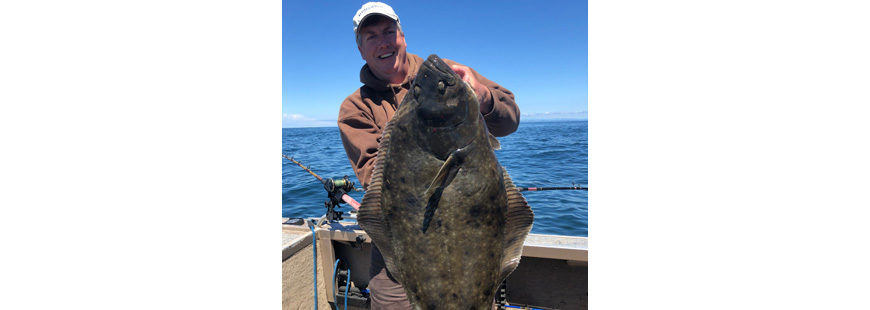Photo: Bob Rees with a halibut
Not even one year ago, the bag limit for rockfish in Oregon was seven fish. Today, it’s four. As we experience a downturn in our salmon and steelhead stocks, bottomfishing is only becoming more popular.
Professional fishing guides, who normally stay within the confines of Tillamook Bay for spring Chinook, were making a 20-mile trek to Arch Cape in pursuit of sea bass and an occasional lingcod. The eleven-day catch-and-keep sturgeon fishery had explosive effort this spring, and anglers are turning to warm-water species to meet their recreational needs in a cold-water mecca. What’s going on here?
It’s no secret that the consumptive use of our fishery resources is not going away. Catch-and-release fisheries are becoming more popular, and while that’s a good thing, most Americans, and most of the world for that matter, enjoy consuming seafood. That’s certainly the case in the Pacific Northwest.
Although we’ve seen the systematic ramp down in opportunity for our ocean resources, most would agree it’s necessary for the future of our fisheries. While some fisheries are losing opportunity, innovative fishermen are finding ways to successfully (and hopefully sustainably) exploit other opportunities such as the long-leader fishery now taking place off of the Oregon Coast. This fishery allows for a 10-fish bag limit on slope species of rockfish many have never heard of, such as yellowtail, chillipepper, canary, redstripe, greenstriped, widow, boccachio and the like. It makes for a nice bag limit of high quality fish for those in the know.
There are certainly some knowledgeable sport anglers that are taking advantage of this new-found fishery, but there is a good handful of charter boat operators that have the fishery dialed, taking easy limits on most days.
Leave it to motivated meat anglers to find a way (admittedly, I’m one of those).
Now if you’ve been paying attention to history, an opportunity like this doesn’t go un-noticed by those that have access to this fishery. How long will it be before this fishery gets inundated with effort, and we have to start lowering catch limits for these species as well? Only time will tell that story, but if history repeats itself, if salmon, steelhead, sturgeon and other species continue to under-perform, effort will continue to grow for this fishery until changes need to be made.
And Salty Dawgs are also keeping their eyes on the horizon for the arrival of albacore tuna, that’s for sure.
You’ve heard me say it before, we have it pretty good here in the Pacific Northwest. Between all the runs of salmon and steelhead (no matter how poor the forecast is), sturgeon bottomfish, halibut, lingcod, tuna, crab and on and on, for now anyway, there always seems to be some form of opportunity for the consumptive angler (and non-consumptive, too, of course). I don’t really know how it goes for the rest of the country, my biased self says we have it as good as it gets out west here, so why go anywhere else?
There’s some bad shenanigans going on in the Gulf states, however. Last week, Congress voted on legislation that set a bad precedent no matter what part of the country you live in. HR 200 was introduced by Alaskan Congressman Don Young with co-sponsorship support from Gulf State Congressmen. Some are calling it a “Wolf in Sheep’s Clothing” (it just had a different bill number back then).
I’ve got to credit Gulf state sport anglers for the initiative, but it’s just hard to justify throwing out sound science and policy for short-term gain with no accountability and a real risk to the future of sustainable fisheries.
Rep. Don Young’s H.R. 200:
- Represents a significant step backward and hinder federal fisheries managers’ ability to rebuild and maintain sustainable fish stocks.
- Threatens the law’s strong accountability and responsible management measures – including the requirement to use science-based fishing catch limits.
- Threatens the scientific integrity of the stock assessment process.
It may be challenging to understand what a Gulf coast initiative has to do with west coast fisheries, but setting a precedent of bad policy and compromising future opportunities should not be tolerated in any region or with any publicly-owned resource. I’ve made the comparison before: what if we ignored the way we do business with regards to Columbia River salmon management? Granted, we’re governed under the Endangered Species Act, while offshore stocks are not, but if we were allowed wide-open access to spring Chinook, sturgeon and steelhead, how would that go over for our sons and daughters, grandsons and granddaughters? Haven’t we saddled them with enough challenges?
Furthermore, how would the original authors of the Magnuson-Stevens Act feel about how we’re talking about fisheries management under HR 200? The late Warren Magnuson (D) and the late Ted Stevens (R) would be rather disappointed in their fellow statesmen.
HR 200 has passed in the House, and it’s a critical time for fisheries management. We’re looking to the Senate to build upon the success of the Magnuson-Stevens Act, not roll back its science-based conservation measures as the House did. Let’s keep poor fisheries management where it belongs, never to see the light of day.


